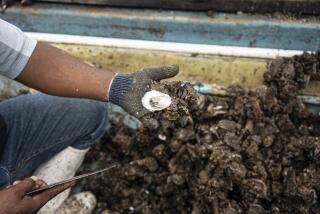Government Doesnât Require Mandatory Inspection of Seafood : Itâs Buyer Beware as Consumption of Fish Increases to an All-Time High
BOSTON â How fresh is the seafood you buy? If you are one of the many Americans who are eating more catfish, swordfish, or fillet of sole these days, you may find that freshness depends on which supermarket or fish store you patronize. The quality can be very inconsistent.
Fish consumption is at an all-time high in the United States because dietary guidelines and health agencies recommend eating more seafood. Americans are eating and enjoying dozens of species--from cod, halibut, salmon and shrimp to mussels, skate, tilapia and sea robin.
The nexus between diet and health has changed food preferences, and Americans are consuming more low-fat foods than before.
This low-fat category includes both fin fish and shellfish. Per capita consumption is 14.7 pounds a year, up more than 11% since 1980. Expectations are that annual consumption may approach 30 pounds by 1990. That is still well shy of chicken, in the 59.5-pound category, and beef, at a dwindling 79 pounds per person.
The demand for seafood keeps climbing because of its high protein content and because of the highly polyunsaturated omega-3 oils, found only in seafoods. Recent oceanic pollution, however, particularly on the mid-Atlantic Coast, has caused concern. More appears to be swimming in the oceans these days than just fish.
But Is Our Fish Healthy?
As consumers, we are concerned about the fish and seafood we consume from a new angle: Are we eating harmful fish and seafood in the quest for a wholesome diet?
Are there hidden hazards in our seafood meals? Are fish and shellfish contaminated with bacteria and industrial chemicals? How do we know?
There is no mandatory inspection of fish in the United States. Unlike meat and poultry, which receive continuous inspection by federal employees, much fish is sold virtually unchecked.
âFish is the only commercially produced flesh food not subject to federal inspection for wholesomeness,â says Ellen Haas, executive director of the Washington, D.C.-based Public Voice for Food and Health Policy.
âThis can be somewhat alarming when you consider that Americans consume over four times as much poultry and five times as much beef as fish, yet seafood caused more illnesses in New York State in 1986 than meat and poultry combined,â Haas said on a visit to Boston.
âMandatory fish inspection is the only way to assure the public of wholesome, good-quality, fresh seafood and decrease the health risk,â says Haas.
âThe real question,â she says, âis, âWhy canât it be mandatory in the U.S. as it is in Canada?â â
Michael Windham, Louisianaâs director of meat and seafood inspection, says the âpotential danger from human consumption of seafood is greater than it ever has been from red meat and poultry.â Windham emphasizes his point, noting, âIf itâs important to have as many as 30 meat inspectors in a single plant, why donât we have at least one in a seafood plant?â
Roger Berkowitz, manager of Bostonâs Legal Sea Foods restaurant chain, says, âFish inspection, yes, Iâm all for it. An inspection by one organization would be a good idea. We have our own fish inspection and it is very strict. We have six restaurants and we consider our inspection and tests of the utmost importance.â
Calls for Wider Controls
Some restaurant owners say itâs not just the fish that needs inspection; the water it comes from and the fishing boats need some kind of standards or certifying. Still others say a well-developed sampling program would be too expensive. Could the government do a good job of it?
Bruce Frankel, owner of the Colony restaurant in Boston, says itâs how fish is handled on the boat that makes a difference. âTwo-day-old fish is OK if itâs been handled properly.â
Susan Loomis, a Seattle-based writer who has just written a seafood book after interviewing almost a hundred fishermen on their boats, says she thinks a more thorough program is needed.
âI realize there is some inspecting going on, but many processors pay for their own inspection,â she says. âBut I think there should be mandatory inspection for fish, since we do have it for meat and poultry and produce. It should also include the imported fish that is flown from ports all over the world into the Fulton Fish Market in New York and to some other cities.â
Existing Regulation
Lee Weddig, executive vice-president of the National Fisheries Institute, sees the plea for mandatory fish inspection in a different light.
âSome people may imply that this is an unregulated, uninspected industry. This just isnât true,â Weddig says. âFish and seafood plants are products subject to the Food and Drug Cosmetic Act, which mandates sanitary facilities and wholesome products. It is enforced by the FDA, which conducts plant and product inspections. Also there are state health agencies that inspect facilities and products and prosecute lawbreakers.â
Another factor, Weddig says, is that âseafood reaches the customer in many different ways. The largest percentage is frozen. The next largest percentage is canned; then comes fresh. A small percentage is smoked or cured.
âTherefore about half the product is ready to eat,â he said, speaking at a Food Marketing Institute conference in Chicago.
âAlmost as much is cooked before consumption by the home cook or at restaurants. This includes the fish fillets, steaks, shrimps and lobster tails. Only a small percentage is eaten raw such as clams, oysters and sashimi,â Weddig says.
Voluntary Inspections
He agrees that consumption of raw fish poses special problems.
âWe do have concerns over environmental hazards which can cause illness,â Weddig says. He explains that many major companies employ the National Marine Fisheries Service on a voluntary basis for more comprehensive inspection service.
âOf the 13 billion seafood meals consumed annually in the United States, very few present a degree of risk more severe than other foods of animal origin,â he says.
Included in these 12 billion to 13 billion seafood servings were 5 billion to 6 billion tuna sandwiches, salads, or casseroles; about 1.5 billion fish sandwiches, and several billion servings of shrimp.
Weddig points out that about 40% of our imported seafood comes from such countries as Canada, Iceland and Norway, which have specialized fishery product inspection programs.
Fish Farming Limits Risks
While the fishing industry still depends on a wild, natural resource, more and more fish and shellfish are being farm raised, with special attention to controlled environment and other quality measures.
The Catfish Institute, for example, realizing that there is no mandatory federal inspection of seafood, adopted the Mississippi Prime Inspection Program in early 1988, to be conducted in conjunction with the U.S. Department of Commerce and the National Marine Fisheries Service.
âWe feel it is vitally important to establish strict standards of excellence for our industry, particularly when there is so much consumer concern about the safety of seafood,â explains Bill Allen Jr., president of the Catfish Institute.
âFDAâs limited programs monitoring fish contamination fall far short of providing assurance that the fish Americans consume is safe,â says Haas.
A number of proposals have been introduced in Congress during the last 20 years to establish a mandatory fish inspection program with jurisdiction over inspection alternately proposed for several departments.
Haasâs Public Voice organization believes the USDA would be the agency that could best administer an inspection program.
âIt has one of the largest research institutions. It has technical expertise and significant expertise because of its experience with poultry and meat inspection.
âIn addition, while FDA has the mandate to protect the American food supply, that is the major mission of the USDA. A mandatory federal inspection system that gives one agency responsibility for its implementation would provide Americans with safer seafood, a potentially nutritious, low-fat source of protein,â Haas says.
Seafood Safety Tips
For safer seafood preparation, follow these steps to make sure that the fish and shellfish you eat are safe:
--Avoid eating raw or partly cooked seafood. Many bacteria are killed by adequately cooking the fish.
--Call or write the local state Department of Public Health to find out if local fish are contaminated. These offices often issue advisories on restricted areas for commercial or sport fishing.
--Be particularly aware of waters near major industrial plants or those contaminated with âred tides.â Do not eat raw seafood or shellfish from areas that are contaminated with either industrial chemicals or biological contaminants.
--Keep all seafood well chilled, between 32 degrees and 40 degrees. All seafood contains some bacteria that can multiply quickly in temperatures above 40 degrees.
--Do not store unfrozen fish more than a few days. Fish and shellfish will ultimately deteriorate.
--Use most frozen seafood within three months. Frozen oily fish have about half the shelf life of frozen lean fish. Use them within two months.
--Keep the freezer as cold as possible, donât crowd it and avoid opening the door unnecessarily.
--Purchase fish and shellfish from reputable dealers with proper storage and handling facilities.
More to Read
Sign up for Essential California
The most important California stories and recommendations in your inbox every morning.
You may occasionally receive promotional content from the Los Angeles Times.










